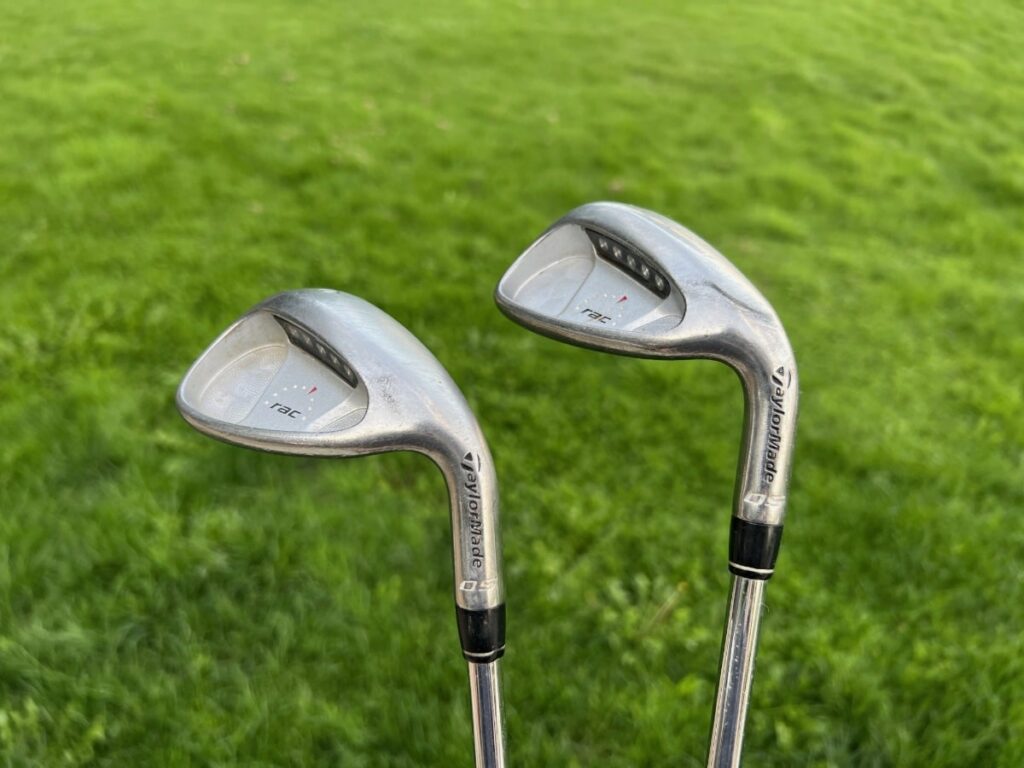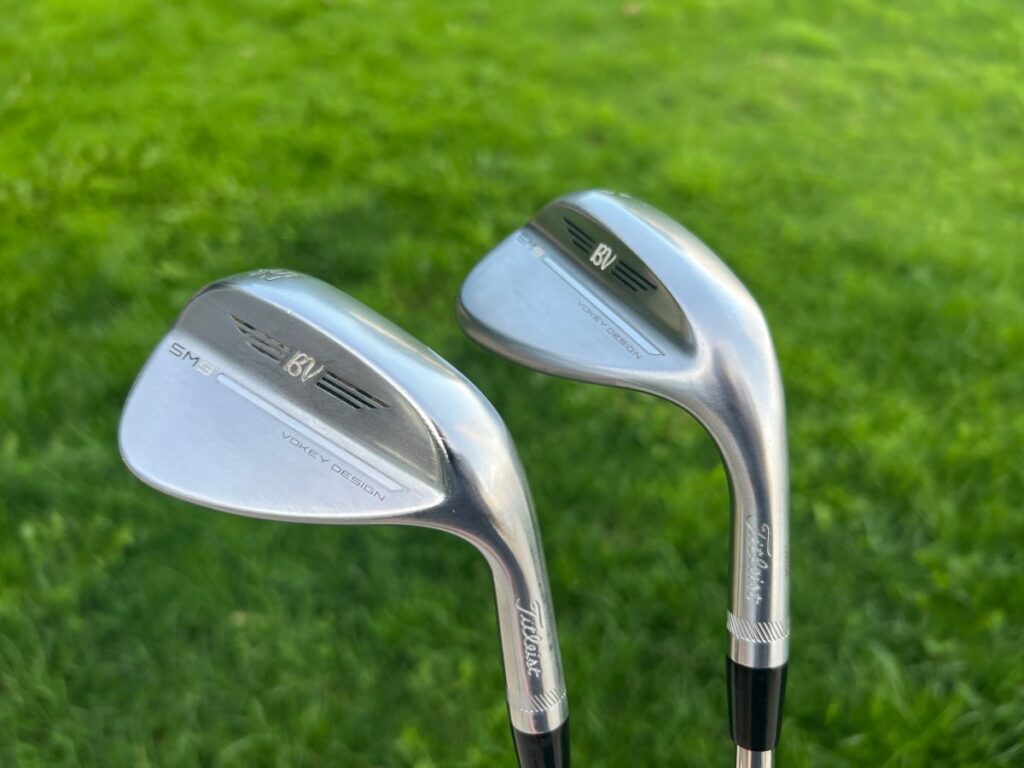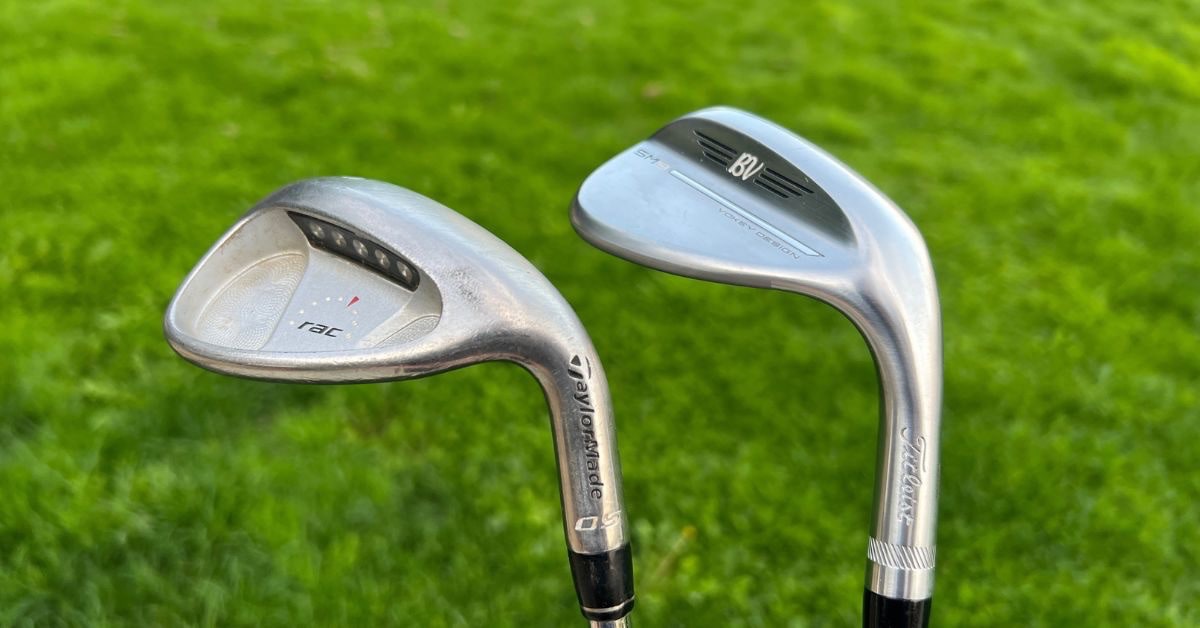When I first started playing golf, I wasn’t too focused on my short game.
It was embarrassing enough to shank the ball at the driving range — so when Sunday rolled around, I was really just trying to stay on the fairway.
Even after I broke 100, the concept of choosing between a set wedge vs specialty wedge was still not at the front of my mind. But fast forward a few years, and it was time to get serious about my short game and lower my scores.
Until that point, I’d been playing the pitching and sand wedges that came with my TaylorMade irons. However, I decided to invest in a set of premium Vokey wedges, and it transformed my short game for the better.
If you’re reading this, you’re likely at a similar point in your golf journey. Read on to learn the differences between a set wedge and a specialty wedge.
Let’s get right into it!
Set Wedge vs Specialty Wedge
Simply put, a set wedge is any wedge included within the iron set you purchased. Typically, this would be a pitching wedge, sand wedge, and maybe a lob wedge. Conversely, a specialty wedge is any wedge that you can buy independently from a set of irons — like Vokey wedges.
In general, a specialty wedge is going to give you more spin and control over launch angles. Set wedges are typically built for forgiveness and to make the transition from your short irons to your wedges less jarring.
Also, a set wedge will match your irons more closely since they were designed to be blended into your iron set. On the other hand, specialty wedges tend to look different from iron sets, since they’re made for flexibility around the greens.
I know what you’re probably thinking — specialty wedges are for low handicappers and set wedges are for beginners and higher handicappers.
But that’s not always the case. You still have to take into account things like course conditions, the types of courses you play, and budget.
To help you make the right decision for your game, check out the following sections that break down the benefits of each type of wedge.
What Are Set Wedges?

In a nutshell, a set wedge is any wedge that was included in your iron set.
Within a complete iron set, you’ll typically get 2-3 wedges included — a sand wedge, a pitching wedge, and possibly a high-lofted lob wedge. But whatever the configuration, set wedges will often closely resemble the irons in the set.
Let’s take a look at the pros and cons of set wedges.
Advantages of Set Wedges
The first and perhaps most clear advantage of a set wedge is the price. A set wedge will almost always be less expensive than a specialty wedge. For instance, a single Vokey Design SM9 wedge costs about $179 while a set of three Kirkland Signature wedges costs a total of $170.
Set wedges also tend to be very forgiving. Usually, the CG (Center of Gravity) in set wedges is very low to help the player achieve a higher launch. They may even have perimeter weighting to help out on lateral mis-hits on the clubface.
Lastly, set wedges can be advantageous because you don’t have to worry about gapping. When you plug a specialty wedge into your arsenal, you have to make sure its loft matches your set so that you don’t get glaring distance gaps.
In summary, set wedges are often:
- Budget-friendly
- Forgiving on mis-hits
- Well-gapped from irons
Now, let’s address the disadvantages of set wedges.
Disadvantages of Set Wedges
On the flip side, set wedges may not give you the spin you need to hold fast greens. Their grooves tend to be less aggressive as they aren’t manufactured as a premium club, so your spin rate might not be up to scratch for certain shots.
Another important consideration is that set wedges lack customization. Almost always, wedges included within a set of irons will have default loft, bounce, and grind properties — which doesn’t suit every swing or course type.
Also, set wedges can lack the feel associated with premium wedges. They don’t have the soft, responsive, or “friction-y” feel that most specialty wedges have.
So, to summarize the disadvantages of set wedges:
- Can lack spin due to cheaper manufacturing
- No customization options for loft, bounce, or grind
- Typically poor feel compared to premium wedges
Next, let’s move on to specialty wedges — my personal favorite.
What Are Specialty Wedges?

Specialty wedges are bought individually and often have unique sole grinds.
They are usually made from premium materials like carbon steel and can be either raw or chrome-plated. They may even be forged to offer a different feel.
Here are the key pros and cons to know when it comes to specialty wedges.
Advantages of Specialty Wedges
One clear advantage is the extra spin that can be generated from the clubface with a good specialty wedge. The sharp, aggressive, and precisely milled grooves add friction to the ball, allowing for more spin so you can stop it dead on the greens.
Customization is another huge benefit of specialty wedges. Typically, you’ll have your choice of sole grind, bounce, and a variety of loft angles — from pitching wedges to gap wedges, sand wedges, and lob wedges.
Specialty wedges also tend to be more workable. They’ll often feature a more compact head shape your average set wedge — often resembling a blade. This allows for better players to shape shots to a higher level than set wedges.
Here are the fundamental advantages:
- Able to generate more spin with the sharp grooves
- Plenty of customization options for loft, bounce and grind
- Generally more workable to allow for shape
Now for the disadvantages!
Disadvantages of Specialty Wedges
Firstly, specialty wedges are often priced at a premium when compared to set wedges. Due to the economics of scale, buying individual clubs will be more expensive than buying a set. Also, they tend to feature premium materials.
In addition, specialty wedges can be less forgiving than set wedges. Often, the sweet spot is smaller and the bounce is lower, so full swings aren’t as easy.
Then, you have to be very careful about bounce and grind options. If you choose the wrong grind or bounce angle for the course conditions you normally play, you will be dealing with some challenging turf interaction.
In summary, here are the disadvantages of specialty wedges:
- They’re often more expensive when bought individually
- Usually, they are less forgiving than set wedges
- Need careful consideration when choosing bounce and grinds
Ultimately, I’m a huge fan of higher-lofted specialty wedges. I carry a pitching wedge from my iron set, along with a specialty sand wedge and lob wedge.
Check out the video below, where Mark Crossfield gives his verdict on using a pitching wedge from an iron set versus a specialist wedge:
Final Thoughts
Nowadays, specialty wedges are being designed to blend better into iron sets so the decision between a set wedge vs specialty wedge is getting difficult.
But you really have to pay attention to the point at which you really want to start manipulating your shots. For instance, if you aren’t really trying to work the ball until your 47 or 48-degree wedge, you can get away with using a set pitching wedge.
Also, course conditions play a role. If you typically play in wet conditions, a wedge with milled grooves will help you wick away moisture and get cleaner contact with the ball. This is where you might want to think about specialty wedges.
At the end of the day, the choice is highly personal. It depends very much on the type of shots you typically need to make and what you’re comfortable with. So it’s always a good idea to go in for a fitting if at all possible.


